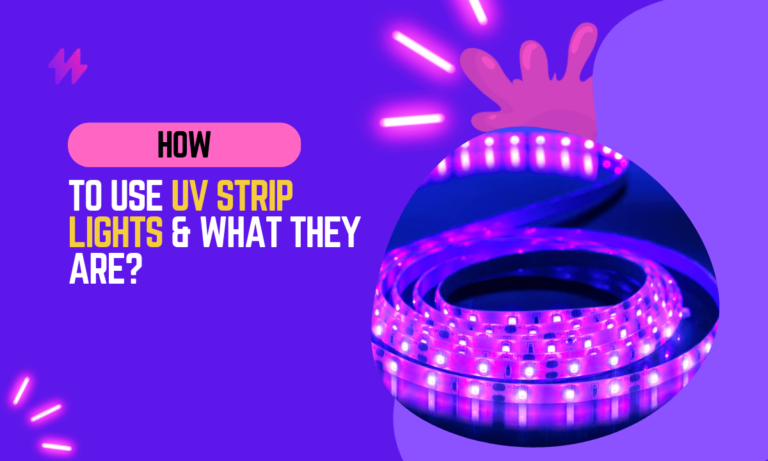Are LED Strip Lights Allowed in Dorms?
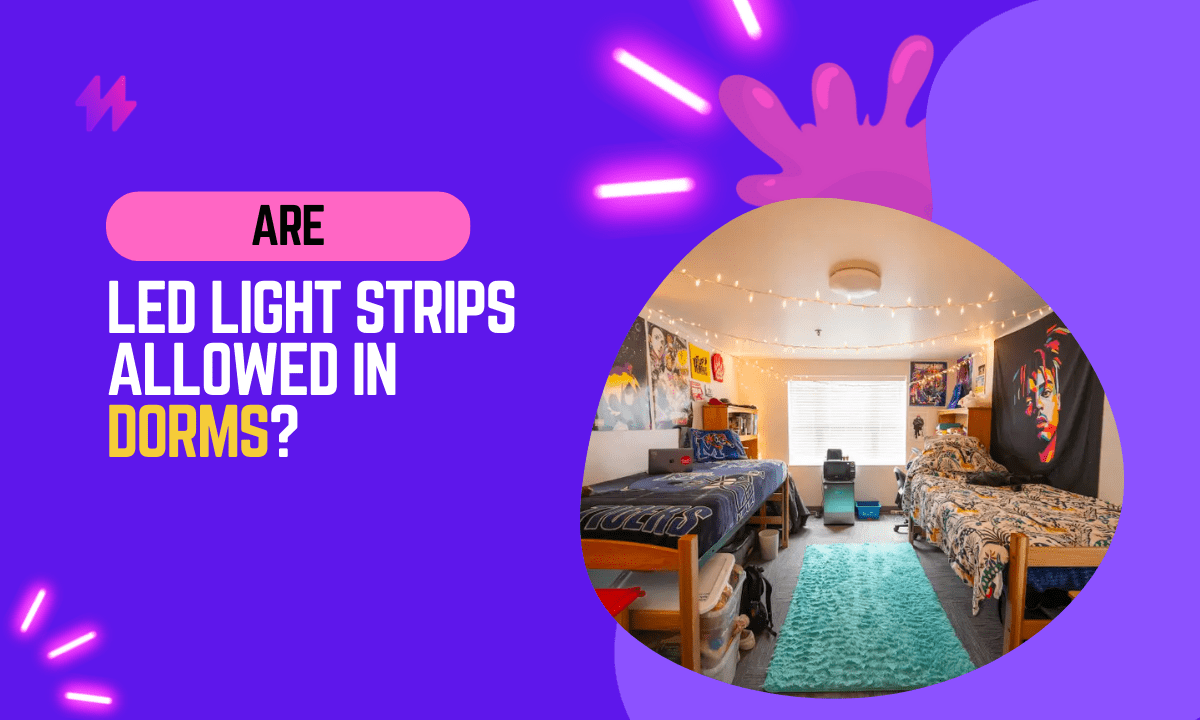
In recent years, LED strip lights have become a popular way to personalize and add a vibrant touch to living spaces, especially among college students looking to add some flair to their dorm rooms. However, whether or not these lights are allowed in dormitories is a topic that requires a detailed exploration.
This article will take you into the world of LED strip lights in the context of dorm living, examining the rules, safety concerns, and creative ways to use them without breaching any regulations.
Before diving into their permissibility in dorms, it’s crucial to understand what LED strip lights are. These are long, flexible circuits populated with LED lights. They are prized for their energy efficiency, low heat emission, and the vibrant, colorful light they emit.
They often come with adhesive backing and a remote control to change colors and patterns.
LED strip lights also offer a creative alternative to traditional lighting fixtures, enhancing not only dorm rooms but also other areas like shared common spaces in residence halls. When decorating, it’s important to abide by residence hall guidelines—while some policies permit the use of glow lights and decorative lighting, always check for any restrictions on specific items such as neon signs or power strips.
Are LED Strip Lights Allowed in Dorms? | Understanding Rules and Safety
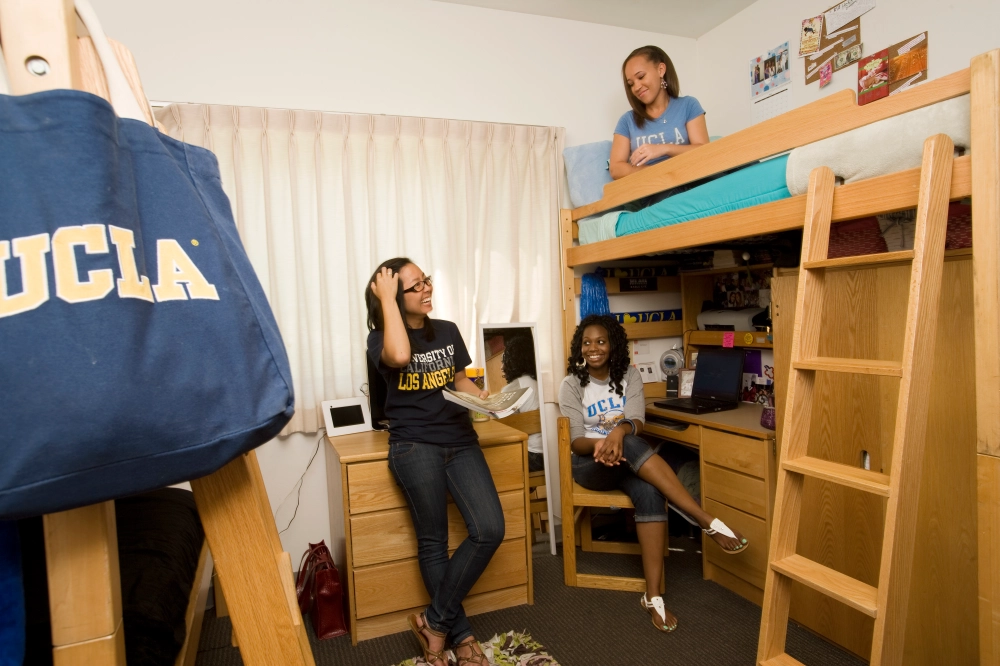
The allowance of LED strip lights in dorms varies from one educational institution to another. While some colleges and universities permit their use due to their energy efficiency and low fire risk, others may have restrictions or outright bans. These restrictions could be due to concerns about fire hazards, potential damage during installation, or electrical safety.
Students need to consult their specific college’s housing policies or speak with a residential advisor to understand the regulations regarding LED strip lights in their dormitories. Compliance with these guidelines is crucial to ensure safety and adherence to dormitory rules.
Also read: How to Choose the Right Voltage for LED Strip Lighting?
Students should also consider how LED strip lights can complement other types of lighting in their residence hall room, such as desk lamps or ceiling fixtures. The versatility of these lights allows them to serve as vibrant wall decor, adding personality to the space while adhering to the housing office’s guidelines.
Dormitory Guidelines: Rules and Regulations for LED Strip Lights
The primary concern with any electrical appliance in dormitories revolves around safety. Dorm rules are primarily designed to prevent fire hazards and ensure the well-being of all residents. Here are some general guidelines:
When decorating dorm rooms, it’s essential to consider both style and safety. Utilizing decorative options such as LED strip lights can create an inviting atmosphere, but it’s crucial to verify if “are LED strip lights allowed in dorms” before installation, as regulations differ across on-campus residence halls.
**Check Your College’s Policy on LED Strip Lights in Dorms**
Every college and university will have its own rules regarding what is and isn’t allowed in their dorms. Some may explicitly mention LED strip lights, while others may have broader rules that could apply to them.
As students personalize their spaces, many opt for decorative options such as rope/string/strip lights to enhance their dorm ambiance. It’s advisable to review the residence hall manual for any guidelines regarding the use of neon lights or other lighting fixtures to ensure a clean residence hall that reflects individual style.
2. Understanding Fire Safety Regulations for LED Strip Lights in Dorms
LED lights are generally considered safe and have a lower fire risk than traditional incandescent bulbs. However, cheap or poorly made LED lights can pose a risk. Ensure that any lights you bring into your dorm are certified for safety (look for marks from UL, ETL, or a similar organization).
Adding LED lights to your residence hall can greatly enhance the overall ambiance of your space while remaining mindful of safety standards. Keep in mind that some residence halls may allow small decorative neon signs, but always check for specific regulations that may impact your choice of lighting fixtures.
3. LED Strip Lights Installation Restrictions in Dorms:
Some dorms might allow LED lights but restrict how they can be installed. For instance, using nails or screws might be prohibited, while adhesive strips might be acceptable.
It’s also wise to think about the type of room types available in your residence hall, as some may have unique rules for installation based on layout and furniture arrangement. Whether you’re planning to accentuate your space with neon lights energy or opt for alternative lighting like desk/study lamps or paper lamp shades, always prioritize safety practices throughout your decorating process.
Why LED Strip Lights Are Favored in Dorms: Exploring Their Popularity
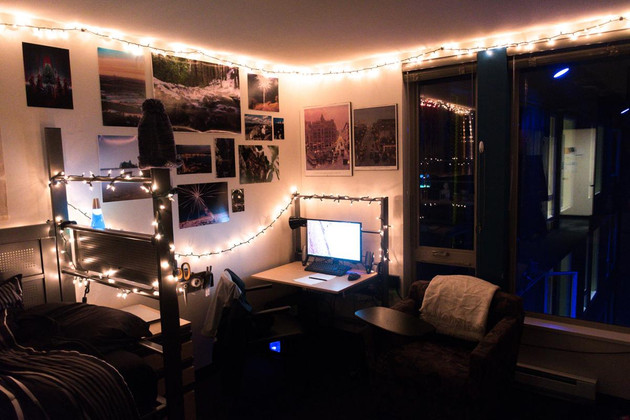
LED strip lights offer several advantages that make them particularly appealing to college students:
Optimizing the use of LED strip lights can drastically transform your residence hall community and create a more inviting atmosphere in your room or suite. Incorporating festive holiday lights or neon lights halogen alongside other light fixtures, such as lanterns and halogen lamps, can reflect your personal style while maintaining compliance with dorm regulations.
- Personalization: They allow students to personalize their space uniquely.
- Mood Lighting: The ability to change colors and brightness can create different moods in the room.
- Space Saving: Being compact and flexible, they don’t take up much space.
Essential Safety Tips for Using LED Strip Lights in Dorms
If your dorm allows LED strip lights, here are some safety tips to keep in mind:
When utilizing LED strip lights in your dorm, make sure to check their compatibility with existing light bulbs and ensure they don’t interfere with fluorescent lighting setups. Remember that safety is crucial, especially in shared spaces like bathrooms and during your sophomore year dorm experience, so always have a backup flashlight on hand in case of power outages.
- Buy Quality Products: Invest in lights from reputable brands to ensure safety and durability.
- Avoid Overheating: Don’t cover LED strips with fabric or paper, as this could pose a fire risk.
- Proper Installation: Follow the manufacturer’s instructions for installation and use the correct power adapters.
- Electrical Load: Ensure that LED strips don’t overload the room’s electrical circuits.
Innovative Ideas for Using LED Strip Lights in Dorms
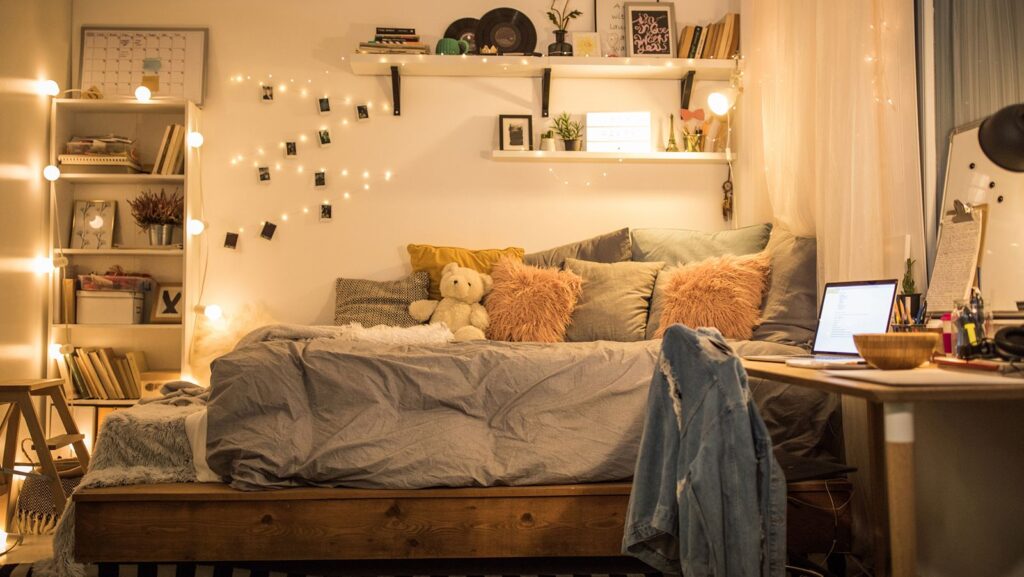
If you’re cleared to use LED strip lights, here are some creative ideas:
If you’re cleared to use LED strip lights, here are some creative ideas: Consider integrating the LED strip lights with your curtains to create a cozy ambiance in your bedroom that mimics candlelight. Additionally, using LED lights alongside torchiere lamps can enhance the overall glow of your room/suite while keeping the atmosphere relaxing and inviting for you and your roommate.
- Under-Bed Lighting: Adds a cool and functional glow.
- Desk Accent: Illuminate your work or study area.
- Wall Art: Create patterns or outlines on the wall for a decorative effect.
- Closet Lighting: Brighten up dark closets for better visibility.
Exploring Alternatives to LED Strip Lights for Dorms: What to Consider
If your dorm prohibits these lights, consider these alternatives:
- String Lights: Often allowed, these can create a cozy, warm atmosphere.
- Desk Lamps with Colorful Bulbs: Offer personalized lighting without the installation hassle.
- LED Candles: Provide ambient lighting and are usually fire-safe.
Also read: What Does LED Density on an LED Strip Mean?
When it comes to selecting lighting options in your residence hall, consider alternatives like compact fluorescent bulbs that provide efficiency and brightness. Additionally, utilizing decor elements like posters can complement your chosen lighting, ensuring that your space remains both vibrant and within the guidelines of your residence hall network.
Conclusion: Understanding the Rules and Benefits of LED Strip Lights in Dorms
In conclusion, the question of whether LED strip lights are permissible in dorm rooms hinges on several factors, primarily dictated by specific university policies and safety regulations. Each institution may have different rules regarding the use of such decorative items, primarily out of concern for fire safety and energy conservation. Before installing LED strip lights, students should thoroughly review their dormitory’s regulations or consult with residence life staff to avoid any violations that could potentially lead to disciplinary action. Additionally, considering the safety features of the LED strip lights, such as their power source, voltage, and whether they have a fire-resistant coating, is crucial to ensure they align with both university guidelines and general safety standards.
Moreover, beyond mere compliance with rules, the use of LED strip lights in dorm rooms can significantly enhance the living space, making it feel more personalized and welcoming. These lights can be used creatively to highlight specific areas, provide dimmed lighting for studying, or simply add a warm, ambient glow to the room. For many students, these modifications can make the limited space of a dorm room feel more like home, thereby improving comfort and satisfaction with their living environment. However, the key to incorporating such enhancements successfully lies in balancing personal expression with adherence to dorm policies. By doing so, students can enjoy the benefits of a customized, comfortable living space without contravening the boundaries set by their university.
Are LED Strip Lights Allowed In Dorms | Checking with Dorm Advisors About LED Strip Lights
Open communication with dorm advisors is essential in determining whether LED strip lights are allowed in dorms. Students often wonder, “Are LED Strip Lights Allowed in Dorms” while comparing them to traditional halogen lights or even black light bulbs, which can create an insufferable light. The right lighting choice can enhance the ambiance of a space filled with lofted furniture. Unlike the harsh glow of big light fixtures, LED strips can offer a softer, more customizable experience that may be preferred over the limited illumination of a phone flashlight. Engaging in a dialogue with dorm advisors helps clarify any restrictions and encourages students to express their creative lighting ideas.
Are LED Strip Lights Allowed in Dorms | Importance of Open Communication with Dorm Advisors
Open communication with dorm advisors is essential when considering the use of LED strip lights in your living space. Students often want to personalize their indoor environment. Clarity on policies ensures that you remain compliant with dorm regulations. Understanding whether LED strip lights are allowed in dorms will prevent unnecessary conflicts and potential penalties. Engaging in conversation with your advisor can provide valuable insights into permissible decor options.
Knowing the specific guidelines laid out by your dormitory can significantly enhance your living experience. Discussing your plans for LED strip lights allows you to address any concerns regarding safety or electrical usage. This proactive approach helps to create a positive relationship with dorm management while also ensuring a comfortable and enjoyable indoor atmosphere. Clear discussions about whether LED strip lights are allowed in dorms can lead to creative solutions that respect both individual expression and community standards.
How to Approach Your Dorm Advisor about LED Strip Light Policies
Initiating a conversation with your dorm advisor about LED strip lights can set a positive tone for your living experience. Start by expressing your interest in enhancing the ambiance of your dorm room. Share your understanding of whether LED strip lights are allowed in dorms and ask for clarification on the policies. This open dialogue shows respect for the rules and demonstrates your willingness to comply with any regulations set by the dormitory.
Preparing for your meeting can also enhance the effectiveness of your discussion. Gather information from reliable sources about the benefits of LED strip lights, emphasizing their energy efficiency and versatility. Present your case thoughtfully by asking specific questions about the dorm’s stance on lighting options. By framing your inquiry around the topic of whether LED strip lights are allowed in dorms, you can open the door to potential solutions that accommodate your needs while adhering to policies.
Understanding the Health Benefits of LED Strip Lights in Dorms
The use of LED strip lights in dorms not only adds a decorative touch but can also contribute positively to students’ well-being. Research shows that different colors of LED lights can have varying effects on mood, helping to create an environment that enhances concentration and promotes relaxation. Students often wonder, “Are LED strip lights allowed in dorms?” and understanding the answer involves recognizing the potential health benefits these lights can provide. The soft glow of certain colors can reduce stress and improve sleep quality, making them a valuable addition to student living spaces. Awareness of these benefits can facilitate open discussions with dorm advisors about policies regarding LED strip lights, ensuring that students make informed choices about their living environment.
Potential Positive Effects of LED Strip Lighting on Mood
LED strip lights can significantly enhance mood in dorms, providing a versatile and customizable lighting solution. Students often seek ways to create a comfortable and inviting atmosphere in their living spaces. The ability to choose various colors and brightness levels allows for personal expression, making it easier to set the right vibe for studying, relaxing, or socializing. However, before installation, it is essential to confirm if are LED strip lights allowed in dorms, as some policies may have specific restrictions.
The psychological effects of lighting play a crucial role in emotional well-being. Bright, warm colors can stimulate positivity and creativity, while cooler shades may promote calmness and focus. This adaptability makes LED strip lights an attractive option for residents looking to improve their living conditions. Understanding the guidelines on whether are LED strip lights allowed in dorms can help students make informed choices that benefit their mental health while adhering to community standards.
Impact of LED Colors on Mental Health in Student Living Spaces
The colors emitted by LED strip lights can significantly influence the atmosphere of a dorm room. Bright, warm colors like yellow and orange tend to create a cozy and inviting environment. On the other hand, cooler colors such as blue and green may promote relaxation and focus. For students navigating the challenges of college life, understanding how these colors affect mood can be particularly beneficial. As they consider whether “Are LED Strip Lights Allowed in Dorms,” it’s essential to recognize how color choices can enhance their living space.
Utilizing specific LED colors can also help manage stress levels and improve overall well-being in student environments. For example, blue light exposure has been shown to reduce feelings of anxiety and fatigue, which can be particularly helpful during exam periods. Students must engage with their dorm advisors about the potential impact of LED lighting and its role in creating a conducive study area. Questions like “Are LED Strip Lights Allowed in Dorms?” become crucial as students seek to optimize their space for mental health.
Creative Ways to Incorporate LED Strip Lights in Dorms
Incorporating LED strip lights into your dorm can greatly enhance the living space while showcasing your personal style. Before starting any design project, it is crucial to check if LED strip lights are allowed in dorms, as some institutions have specific regulations. Using LED strip lights to outline shelves, create a soft glow behind your bed, or highlight artwork can significantly change the ambiance of your room. Experimenting with different placements and colors can lead to a more inviting environment that reflects your personality. Remember to keep open communication with dorm advisors to ensure that your creative lighting choices align with dorm policies regarding decoration.
Designing Ambiance with LED Strip Lights
LED strip lights offer a versatile lighting solution that can transform a dorm room’s atmosphere into a cozy retreat. Students often wonder, “Are LED strip lights allowed in dorms?” The answer frequently depends on university policies, but many institutions encourage creative room decor that enhances a student’s living experience. By strategically placing LED strips along walls, furniture, or ceilings, students can create a warm and inviting ambiance for studying or socializing.
The colors and effects achieved with LED strip lights can significantly influence the mood within a dorm space. Soft, warm whites can promote relaxation, while vibrant colors like blue or green may invigorate and energize. Understanding such benefits raises the question, “Are LED strip lights allowed in dorms?” Most dorms recognize the value of personalized lighting as long as it adheres to safety standards. This balance allows students to enjoy a well-lit environment that complements their lifestyle and preferences.
DIY Projects Using LED Strip Lights for Personalization
Creating personalized designs with LED strip lights can significantly enhance the atmosphere of a dorm room. Students often wonder, “Are LED Strip Lights Allowed in Dorms?” Understanding the guidelines will help inspire creativity while ensuring compliance with dorm regulations. Simple projects like outlining shelves, creating geometric patterns on walls, or illuminating corners can transform an ordinary space into a vibrant and welcoming environment.
Experimenting with different placements and colors allows students to express their unique styles. Applying LED strip lights to furniture, such as under desks or around bed frames, can create a cozy and inviting feel. In considering the question, “Are LED Strip Lights Allowed in Dorms,” it’s essential to connect with dorm advisors to ensure that personalized projects align with safety protocols while maximizing aesthetic appeal.


